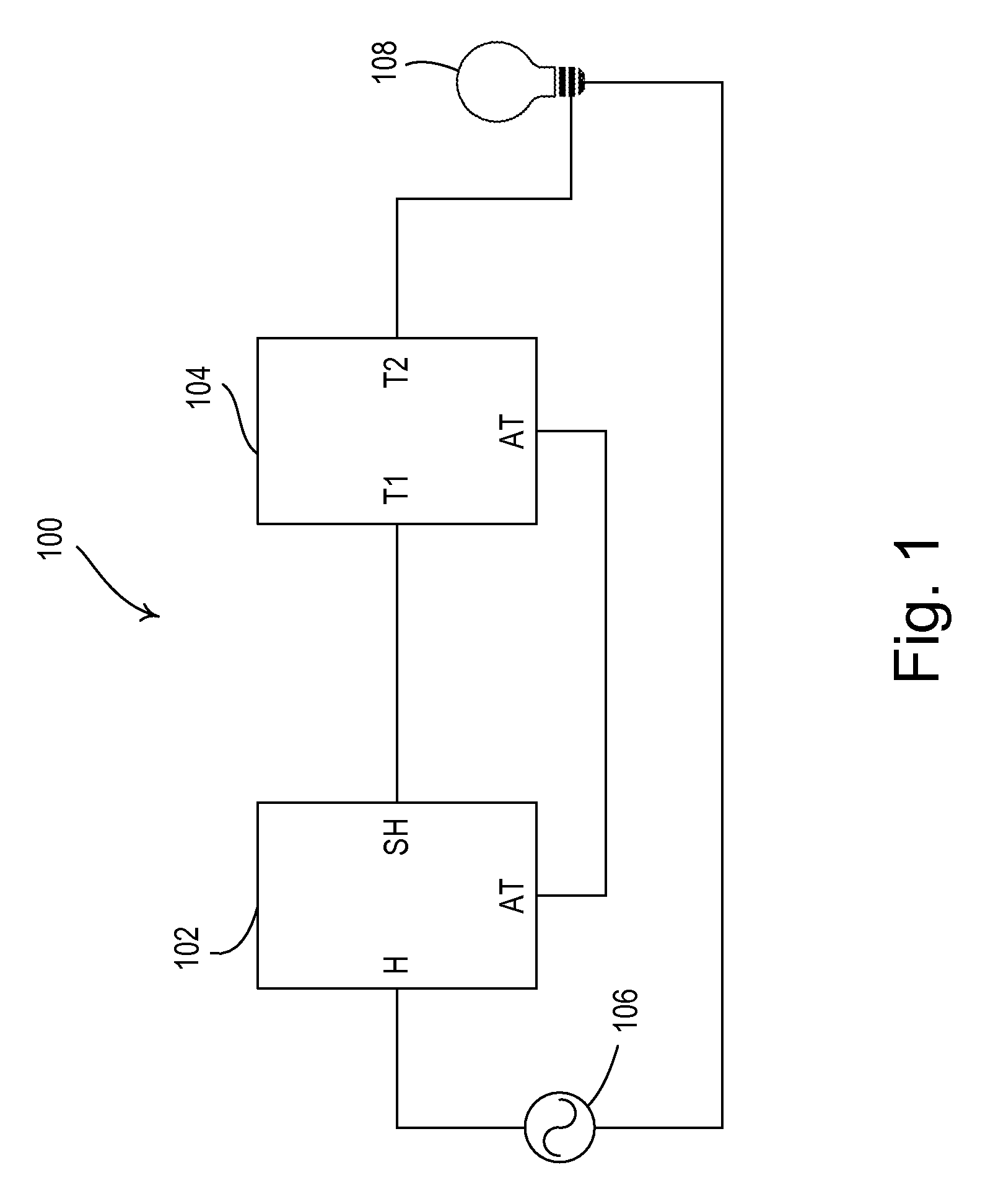Multiple location electronic timer system
a technology of electronic timer and multi-location, applied in the direction of electrical equipment, light sources, electric light circuit arrangements, etc., can solve the problem that the remote electronic timer provides only limited functionality
- Summary
- Abstract
- Description
- Claims
- Application Information
AI Technical Summary
Benefits of technology
Problems solved by technology
Method used
Image
Examples
first embodiment
[0032]FIG. 1 is a simplified block diagram of a multiple location electronic timer system 100 according to the present invention. The timer system 100 comprises an electronic timer 102 and an accessory timer 104 (i.e., a plurality of timer control devices). The electronic timer 102 and the accessory timer 104 are both coupled in series between an alternating-current (AC) power source 106 and a connected electrical load, for example, a lighting load 108 or a motor load, such as an exhaust fan. The electronic timer 102 is coupled to the AC power source 106 via a hot terminal H and is coupled to the accessory timer 104 via a switched-hot terminal SH. The accessory timer 104 is coupled to the electronic timer 102 via a first terminal T1 and to the lighting load 108 via a second terminal T2, such that the accessory timer 104 is connected on the load side of the timer system 100 as shown in FIG. 1. Note that the accessory timer 104 could alternatively be coupled to the AC power source 106...
second embodiment
[0066]FIG. 7 is a simplified block diagram of a multiple location electronic timer system 700 according to the present invention. The timer system 700 includes a plurality of accessory timers 104 (e.g., three accessory timers as shown in FIG. 7). The accessory timer terminal AT of each of the accessory timers 104 is coupled to the accessory timer terminal AT of the electronic timer 102, such that the electronic timer 102 is operable to control the lighting load 108 in response to actuations of the control actuator 134 or the timer adjustment actuator 136 of any of the accessory timers 104. Since the accessory timers 104 are essentially coupled in parallel, the electronic timer 102 is responsive to actuations of the control actuators 134 and the timer adjustment actuators 136 of each of the accessory timers.
[0067]The operation of a multiple-location lighting control system that does not include electronic timers is described in greater detail in commonly-assigned U.S. Pat. No. 5,798,...
third embodiment
[0068]FIG. 8 is a simplified block diagram of a radio-frequency (RF) multiple location electronic timer system 800 according to the present invention. The timer system 100 comprises an RF electronic timer 802 coupled between the AC power source 102 and the lighting load 108 and a plurality of RF accessory timers 804 (e.g., two accessory timers as shown in FIG. 8). The electronic timers 802 and the accessory timers 804 all include control actuators 114, 134, timer adjustment actuators 116, 136, and visual indicators 118, 138. The RF timer system 800 uses a two-way RF communication link for communication of RF signals 805 between the electronic timer 802 and the accessory timers 804. Examples of RF lighting control systems are described in greater detail in commonly-assigned U.S. Pat. No. 5,905,442, issued May 18, 1999, entitled METHOD AND APPARATUS FOR CONTROLLING AND DETERMINING THE STATUS OF ELECTRICAL DEVICES FROM REMOTE LOCATIONS, and commonly-assigned U.S. Pat. No. 6,803,728, is...
PUM
 Login to View More
Login to View More Abstract
Description
Claims
Application Information
 Login to View More
Login to View More - R&D
- Intellectual Property
- Life Sciences
- Materials
- Tech Scout
- Unparalleled Data Quality
- Higher Quality Content
- 60% Fewer Hallucinations
Browse by: Latest US Patents, China's latest patents, Technical Efficacy Thesaurus, Application Domain, Technology Topic, Popular Technical Reports.
© 2025 PatSnap. All rights reserved.Legal|Privacy policy|Modern Slavery Act Transparency Statement|Sitemap|About US| Contact US: help@patsnap.com



